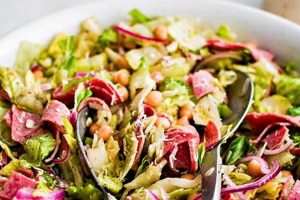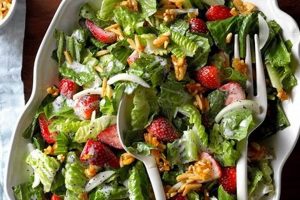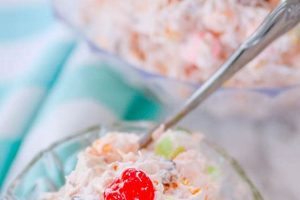Layered salads assembled in jars offer a convenient and portable meal solution. Typically, dressings are placed at the bottom, followed by denser vegetables, grains, proteins, and finally, lighter greens. An example might include a vinaigrette base, layered with chopped cucumbers, quinoa, grilled chicken, and topped with spinach.
This method of salad preparation offers several advantages. It keeps delicate greens from wilting, allowing for advance preparation and convenient transport to work or school. The layering also prevents ingredients from mixing prematurely, ensuring a fresh and flavorful experience at mealtime. While the precise origin is difficult to pinpoint, the increasing popularity of meal prepping and portable lunches has undoubtedly contributed to the widespread adoption of this technique.
Further exploration will cover practical tips for creating these layered salads, including ingredient selection, layering strategies for optimal freshness, and variations to cater to different dietary needs and preferences.
Tips for Creating Layered Salads
Creating successful layered salads requires attention to ingredient selection and layering order to maximize freshness and flavor.
Tip 1: Start with the Dressing: Placing the dressing at the bottom prevents other ingredients from becoming soggy. A robust vinaigrette works well, as does a creamy dressing if used sparingly.
Tip 2: Layer Sturdy Vegetables Next: Hearty vegetables like chopped carrots, bell peppers, cucumbers, and onions form a protective barrier between the dressing and more delicate components.
Tip 3: Incorporate Grains and Proteins: Cooked grains like quinoa, farro, or rice, along with protein sources such as beans, lentils, grilled chicken or tofu, create a substantial and satisfying meal.
Tip 4: Add Lighter, More Delicate Ingredients: Softer vegetables like tomatoes or avocado should be placed above the grains and proteins to prevent crushing. Cheese crumbles also fit well in this layer.
Tip 5: Top with Leafy Greens: Delicate greens such as spinach, romaine lettuce, or arugula should be placed at the top of the jar to prevent them from wilting. Pack them loosely to allow for some air circulation.
Tip 6: Secure with a Lid: Ensure an airtight seal to maintain freshness and prevent leakage.
Tip 7: Shake Before Serving: Just before eating, shake the jar vigorously to distribute the dressing and combine the ingredients.
Proper layering ensures each element remains distinct and fresh until consumption. This method offers a customizable and convenient approach to healthy meal preparation.
By following these guidelines, individuals can create delicious and nutritious salads that remain fresh and flavorful throughout the week, simplifying meal planning and promoting healthy eating habits.
1. Layering
Layering is fundamental to the success of jar salads. This technique serves a crucial function: it prevents premature mixing of ingredients, thus preserving the integrity and freshness of individual components. Dressings placed at the bottom avoid contact with delicate greens, preventing sogginess. Denser vegetables create a barrier between the dressing and more sensitive ingredients like grains or proteins. This strategic placement ensures that each element remains distinct and flavorful until consumption. A typical example involves a vinaigrette at the base, followed by chopped carrots and cucumbers, then quinoa or grilled chicken, and finally, a topping of spinach leaves.
The practical implications of proper layering are significant. It allows for advance preparation of salads without compromising quality. A jar salad prepared the night before remains just as fresh and appealing at lunchtime the following day. This aspect makes jar salads ideal for meal prepping and busy schedules. Layering also facilitates portion control and balanced meals. The defined layers allow for precise measurement of ingredients, aiding dietary planning. Furthermore, the visual appeal of the layered salad enhances the dining experience.
In essence, layering is not merely an aesthetic choice but a functional necessity in jar salad construction. It is the key to preserving freshness, promoting convenience, and ensuring a satisfying and flavorful meal. Understanding and applying this principle is crucial for successfully utilizing this meal preparation technique. While the concept is simple, its impact on the overall quality and enjoyment of the salad is profound.
2. Ingredient Choice
Ingredient choice is paramount in crafting successful layered salads. The selection directly impacts not only flavor and nutritional value but also the structural integrity and longevity of the assembled salad. Certain ingredients hold up better than others within the confines of a jar, and understanding these nuances is critical. For instance, robust vegetables like carrots and bell peppers maintain their texture, while delicate ingredients like tomatoes or avocados might become mushy if placed at the bottom of the jar beneath heavier items. Leafy greens, if positioned below denser components, are prone to wilting and bruising. Selecting ingredients with complementary flavors and textures is also crucial for a balanced and enjoyable culinary experience. Compatibility between components is key; a strongly flavored vinaigrette, for example, might overpower delicate greens.
Consider the layered salad paradigm. A bed of quinoa forms a sturdy base and provides a source of protein and complex carbohydrates. Grilled chicken breast adds further protein and a savory element. Chickpeas offer a vegetarian protein alternative and contribute a creamy texture. Chopped cucumbers and bell peppers introduce refreshing crispness. A sprinkle of feta cheese provides a salty tang. Finally, a crown of spinach adds essential vitamins and minerals. This example demonstrates how diverse ingredients can harmonize within the layered format, offering a nutritionally complete and flavorful meal.
Successful ingredient choice hinges on understanding the interplay between texture, flavor, and placement within the jar. Careful consideration of these factors yields a salad that not only remains fresh and appealing but also delivers a delightful and balanced culinary experience. Ignoring these principles can result in a soggy, unappetizing, and nutritionally compromised meal. Mastering the art of ingredient selection is thus essential for maximizing the potential of the layered salad technique.
3. Jar Size
Jar size plays a crucial role in the success of layered salads. The chosen vessel dictates portion control, influences ingredient selection, and impacts overall portability and practicality. Selecting an appropriate jar size is essential for optimizing the layered salad experience.
- Portion Control
Jar size directly influences portion sizes. Smaller jars are suitable for individual servings or lighter meals, while larger jars accommodate larger appetites or multiple servings. A 16-ounce jar might suffice for a light lunch, whereas a 32-ounce jar might be preferred for a more substantial meal or for sharing. Choosing the correct size ensures appropriate calorie intake and minimizes food waste.
- Ingredient Selection and Layering
Jar size impacts ingredient selection and layering strategies. Larger jars offer more versatility in incorporating a wider variety of ingredients and creating more complex layers. Smaller jars might necessitate more selective ingredient choices and simpler layering strategies. A wide-mouth jar allows for easier layering of larger items like chicken breast or whole cherry tomatoes, while a narrow-mouth jar might be more suitable for finely chopped ingredients.
- Portability and Storage
Jar size affects portability and storage. Smaller jars are generally more convenient for transport in lunch bags or backpacks, while larger jars might be less portable. Storage space considerations also factor into jar size selection. A collection of smaller jars might occupy more refrigerator space than a few larger ones. The chosen size should align with individual lifestyle and storage capabilities.
- Aesthetic Presentation
While primarily functional, jar size also influences the aesthetic presentation of the salad. The chosen size can enhance the visual appeal of the layered ingredients. Taller, narrower jars create a visually striking presentation of the layers, while shorter, wider jars offer a different aesthetic. Consider the visual impact when selecting a jar for layered salads.
Appropriate jar size selection is integral to optimizing layered salads. Consider portion control, ingredient compatibility, portability, and aesthetic preferences when selecting a jar. A thoughtful approach to jar size ensures not only a practical and convenient meal but also an aesthetically pleasing and enjoyable dining experience.
4. Portability
Portability represents a significant advantage of layered salads in jars. This inherent characteristic distinguishes them from traditional salads served in bowls or containers less conducive to transport. The sealed environment of a jar maintains the salad’s structural integrity and prevents spills during transit, making it an ideal choice for meals consumed outside the home.
- Leak-Proof Design
Jars, particularly those with secure lids, offer a leak-proof environment crucial for transporting dressings and sauces without spillage. This feature eliminates the need for separate dressing containers and reduces the risk of messy accidents during commutes or outdoor activities. The airtight seal maintains the integrity of the layered components, preventing premature mixing and preserving freshness until consumption.
- Compact Form Factor
The cylindrical shape of jars allows for efficient packing in lunch bags, backpacks, or briefcases. They occupy less space compared to traditional containers and fit neatly alongside other items. This compact form factor contributes to the convenience and practicality of transporting layered salads, making them ideal for individuals on the go. The rigid structure of the jar also protects the salad from being crushed during transit, unlike more pliable containers.
- Durability and Reusability
Glass jars offer durability and reusability, making them a sustainable choice for meal transport. Unlike disposable containers, jars can be washed and reused multiple times, reducing waste and promoting environmentally conscious practices. Their robust construction withstands the rigors of daily transport, ensuring long-term utility and cost-effectiveness.
- Enhanced Food Preservation
The airtight seal of a jar helps preserve the freshness and quality of the salad ingredients. This contained environment minimizes exposure to air and external contaminants, delaying oxidation and preserving the vibrant colors and flavors of the components. The layered structure further contributes to preservation by preventing delicate greens from coming into direct contact with the dressing, thus preventing premature wilting and sogginess.
The portability of layered salads in jars significantly enhances their practicality and appeal for individuals seeking convenient and healthy meal options outside the home. This feature makes them a versatile choice for work lunches, picnics, travel, and other situations where transporting a traditional salad would be impractical or cumbersome. The combination of leak-proof design, compact form factor, durability, and enhanced food preservation distinguishes jar salads as a superior option for portable meals.
5. Meal Prepping
Meal prepping and layered salads in jars represent a synergistic relationship within contemporary food preparation practices. Meal prepping, the practice of preparing meals or meal components in advance, finds a natural complement in the jar salad format. The inherent portability and preservation qualities of jar salads align seamlessly with the core objectives of meal prepping: efficiency, convenience, and healthy eating. Jar salads offer a practical solution for individuals seeking to control portion sizes, maintain balanced diets, and minimize time spent on daily meal preparation. The make-ahead nature of jar salads reduces daily cooking demands, streamlining weekly routines. For example, preparing several jar salads on Sunday evening provides grab-and-go lunches throughout the work week, eliminating the need for daily meal assembly. This preemptive approach facilitates adherence to dietary goals and reduces reliance on less healthy, readily available alternatives.
The practical significance of this connection extends beyond mere convenience. Meal prepping layered salads contributes to improved dietary adherence. Having readily available, healthy meal options reduces the likelihood of impulsive, less nutritious choices driven by time constraints or lack of preparation. This proactive approach empowers individuals to maintain balanced diets, even amidst demanding schedules. Furthermore, the economic benefits are noteworthy. Planning meals and preparing them in advance often results in reduced food waste and lower overall grocery expenses. By utilizing readily available ingredients and minimizing reliance on expensive takeout or convenience foods, meal prepping contributes to financial savings. For instance, purchasing ingredients in bulk and preparing multiple jar salads at once is often more economical than purchasing individual lunch items daily.
The synergy between meal prepping and jar salads offers a practical and effective strategy for individuals seeking to improve their dietary habits and streamline their weekly routines. This approach addresses challenges associated with time constraints, portion control, and healthy food choices. By embracing the principles of meal prepping and leveraging the convenience and portability of jar salads, individuals can establish sustainable healthy eating patterns and optimize their nutritional intake. The combined benefits of these practices contribute significantly to overall well-being and represent a valuable tool in achieving long-term health goals.
Frequently Asked Questions
This section addresses common inquiries regarding layered salads in jars, providing practical guidance and clarifying potential misconceptions.
Question 1: How long do layered salads last in a jar?
Properly prepared and stored layered salads typically last for 3-5 days in the refrigerator. The shelf life depends on ingredient selection and storage temperature consistency.
Question 2: What types of dressings work best for jar salads?
Vinaigrettes are generally preferred due to their lower density and reduced risk of making other ingredients soggy. Creamy dressings can be used sparingly, but their placement within the layered structure requires careful consideration.
Question 3: Can layered salads be frozen?
Freezing is generally not recommended. The textures of many ingredients, particularly leafy greens and vegetables, are negatively impacted by freezing and thawing. The structural integrity of the salad is often compromised upon thawing.
Question 4: What are the best types of jars to use for layered salads?
Wide-mouth jars facilitate easier layering and access to the salad upon consumption. Glass jars are preferred for their durability, reusability, and ability to withstand temperature fluctuations. The size of the jar should correspond with individual portion needs and storage space considerations.
Question 5: How can one prevent the salad from becoming soggy?
The layering technique itself is designed to prevent sogginess. Placing the dressing at the bottom, followed by denser vegetables, grains, proteins, and finally, delicate greens, isolates the dressing from the more sensitive ingredients. Ensuring a tight seal on the jar also helps maintain optimal ingredient freshness.
Question 6: Are there any specific dietary restrictions to consider when preparing layered salads?
Layered salads offer high adaptability to various dietary needs. Ingredient selection allows for customization according to vegan, vegetarian, gluten-free, or paleo dietary restrictions. Careful attention to ingredient sourcing and preparation can address specific allergen concerns.
Understanding these key aspects optimizes the layered salad experience, ensuring freshness, convenience, and enjoyment. Proper preparation and storage techniques maximize the longevity and quality of these versatile and healthy meals.
The following sections will provide detailed recipe examples and further explore variations based on dietary preferences and seasonal ingredient availability.
Conclusion
Layered salads assembled in jars offer a practical and adaptable approach to meal preparation. Strategic layering preserves ingredient integrity, preventing premature mixing and ensuring optimal freshness. Ingredient selection, jar size considerations, and portability enhance the convenience and adaptability of this method, aligning seamlessly with contemporary meal prepping practices. Understanding these elements allows for customization based on individual dietary preferences, portion control needs, and lifestyle demands.
This method represents a versatile solution for individuals seeking convenient, healthy, and aesthetically pleasing meals. The ability to prepare layered salads in advance simplifies weekly meal planning and promotes consistent adherence to dietary goals. Further exploration and experimentation with diverse ingredients and flavor combinations offer limitless possibilities within this adaptable framework, fostering creativity and culinary enjoyment within a practical and health-conscious approach to meal preparation.






